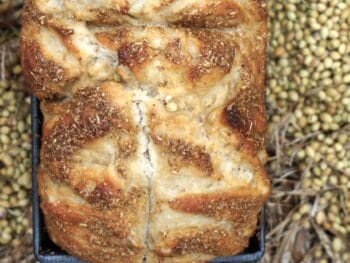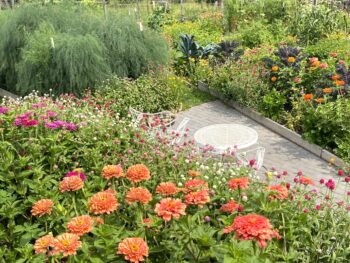Our Lenten bread adventure simply must end with barley, for this humble grain stands witness in God’s Word to all we celebrate this weekend. The time of barley harvest was the background of the Israelites’ deliverance from slavery in Egypt (Exodus 9:31), the epic story celebrated as the Passover meal. In turn, Passover is the context of Jesus’ death and resurrection (Luke 22:7-8), the ultimate deliverance celebrated as Easter.
Digging deeper into author Jo Ann Gardner’s book, Seeds of Transcendence, I came upon this small sentence, and have been wondrously changed ever since—overcome with the Lord’s breathtaking alignment.
Passover commemorates both the barley harvest and the Israelites’ redemption by God from slavery in Egypt.
—Jo Ann Gardner, Seeds of Transcendence, 2014
Admittedly, I have been hungry for any teaching about grains, flour, or bread lately! However, this beautiful connection of barley to redemption has sent me in a whorl of pondering about God’s greater work of deliverance, his grace, and all he has created in the land to remind us of it. “In this way the physical and spiritual worlds are bound together and interdependent,” writes Gardner.
Barley Horticulture
Barley and wheat are the central cereals of ancient Israel, yet barley is more adaptable to soil shortcomings, cooler temperatures, and water fluctuations; in other words, barley doesn’t have to be “babied.” It is hardy and resilient, standing firm to most inclement weather (except the intense hail of the seventh plague, of course). When processed for flour, kernels do not contain the gluten content of wheat, and thus yield a more dense, rustic bread.
shortcomings, cooler temperatures, and water fluctuations; in other words, barley doesn’t have to be “babied.” It is hardy and resilient, standing firm to most inclement weather (except the intense hail of the seventh plague, of course). When processed for flour, kernels do not contain the gluten content of wheat, and thus yield a more dense, rustic bread.
Barley Signpost
Barley does not hold the delicacies of “finest wheat flour” for dainty cakes and pastries—not delicate but rugged, not noble but unpretentious, barley gives its baked goods a flavor of being close to the earth.
For this is what the high and exalted One says— he who lives forever, whose name is holy: “I live in a high and holy place, but also with the one who is contrite and lowly in spirit, to revive the spirit of the lowly and to revive the heart of the contrite.
Isaiah 57:15 NIV
Barley is the perfect background to the work of the Lord to deliver: First, the Israelites from slavery in Egypt; next, all of us from the slavery of sin and the bondage of death. The barley detail hints to us that the Lord has entered into the humble, common, poor places of enslavement. He willingly lives with us in our lowliness, and lends his power to liberate us. Embracing Christ sets us free from death to live with Him, redeemed to remain with God forever.
I will deliver this people from the power of the grave; I will redeem them from death. Where, O death, are your plagues? Where, O grave, is your destruction?
Hosea 13:14 NIV
Didn’t Ruth know God’s redemption, returning to Israel during the barley harvest, redeemed by her kinsman Boaz? Was Christ whispering his deliverance when he multiplied the barley loaves for the crowd 5,000 strong? May these careful details delight us! May we be convinced of his plan from the beginning, and smitten with his beauty, the richness and hearty depth of his Word and its sustenance.
May you be richly rewarded by the LORD, the God of Israel, under whose wings you have come to take refuge.
Ruth 2:12 NIV
Amid gentle spring breezes and the harvest time for barley, bondage was broken; relief was granted from the days of trouble. The Almighty Lord saved his people from slavery.
—“Festival of Unleavened Bread,” God’s Word for Gardeners Bible, 2014
Photo Credits:
© 2015 Shelley S. Cramm Three little barley loaves decorated with hyssop sprigs are ready for an Easter feast.
© 2014 Jake Cook, Creative Commons Sunset on a local farmers barley field.
Side Notes on baking Barley Bread:
My favorite source for barley flour is Bob’s Red Mill (stores in my area do not stock it so I order online at www.bobsredmill.com). Barley flour may substitute regular flour in your favorite bread recipe. Bob’s recommends a ½ cup substitution, but I mixed 2 cups barley flour and 2 cups whole wheat in my recipe and added an extra 1-½ teaspoon yeast, adding unbleached white flour during kneading.
If you still have your Beard on Bread book out from last week, James Beard includes a more authentic barley recipe to the Passover-Easter feast: Barley Crackers…unleavened, of course (see “Norwegian Flatbread,” page 201)…maybe next year!
You can also bring barley to your table in a side dish. See our Weed & Barley blog for a recipe idea.













